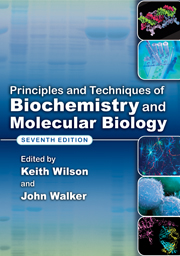Book contents
- Frontmatter
- Contents
- Preface to the seventh edition
- List of contributors
- List of abbreviations
- 1 Basic principles
- 2 Cell culture techniques
- 3 Centrifugation
- 4 Microscopy
- 5 Molecular biology, bioinformatics and basic techniques
- 6 Recombinant DNA and genetic analysis
- 7 Immunochemical techniques
- 8 Protein structure, purification, characterisation and function analysis
- 9 Mass spectrometric techniques
- 10 Electrophoretic techniques
- 11 Chromatographic techniques
- 12 Spectroscopic techniques: I Spectrophotometric techniques
- 13 Spectroscopic techniques: II Structure and interactions
- 14 Radioisotope techniques
- 15 Enzymes
- 16 Principles of clinical biochemistry
- 17 Cell membrane receptors and cell signalling
- 18 Drug discovery and development
- Index
- Plate section
- References
6 - Recombinant DNA and genetic analysis
- Frontmatter
- Contents
- Preface to the seventh edition
- List of contributors
- List of abbreviations
- 1 Basic principles
- 2 Cell culture techniques
- 3 Centrifugation
- 4 Microscopy
- 5 Molecular biology, bioinformatics and basic techniques
- 6 Recombinant DNA and genetic analysis
- 7 Immunochemical techniques
- 8 Protein structure, purification, characterisation and function analysis
- 9 Mass spectrometric techniques
- 10 Electrophoretic techniques
- 11 Chromatographic techniques
- 12 Spectroscopic techniques: I Spectrophotometric techniques
- 13 Spectroscopic techniques: II Structure and interactions
- 14 Radioisotope techniques
- 15 Enzymes
- 16 Principles of clinical biochemistry
- 17 Cell membrane receptors and cell signalling
- 18 Drug discovery and development
- Index
- Plate section
- References
Summary
INTRODUCTION
The considerable advances made in microarray, sequencing technologies and bioinformatics analysis are now beginning to provide true insights into the development and maintenance of cells and tissues. Indeed areas of analysis such as metabolomics, transcriptomics and systems biology are now well established and allow analysis of vast numbers of samples simultaneously. This type of large-scale parallel analysis is now the main driving force of biological discovery and analysis. However, the techniques of molecular biology and genetic analysis have their foundations in methods developed a number of decades ago. One of the main cornerstones on which molecular biology analysis was developed was the discovery of restriction endonucleases in the early 1970s which not only led to the possibility of analysing DNA more effectively but also provided the ability to cut different DNA molecules so that they could later be joined together to create new recombinant DNA fragments. The newly created DNA molecules heralded a new era in the manipulation, analysis and exploitation of biological molecules. This process, termed gene cloning, has enabled numerous discoveries and insights into gene structure, function and regulation. Since their initial use the methods for the production of gene libraries have been steadily refined and developed. Although microarray analysis and the polymerase chain reaction (PCR) have provided short cuts to gene analysis there are still many cases where gene cloning methods are not only useful but are an absolute requirement.
Information
- Type
- Chapter
- Information
- Principles and Techniques of Biochemistry and Molecular Biology , pp. 195 - 262Publisher: Cambridge University PressPrint publication year: 2010
